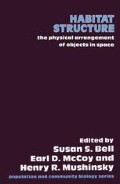Abstract
As one moves from higher latitudes towards the equator, the structure of well-watered climax vegetation becomes progressively more complex (Walter, 1984). Increased structural complexity is manifested in several ways. The number of vertically superimposed crowns seen in profile increases systematically, while additional growth forms, such as lianes, epiphytes and stranglers, join the ensemble at low latitudes (Terborgh, 1985b). Accompanying these other trends is a marked increase in overall community diversity. The striking floristic richness of tropical vegetation has drawn more scientific attention than any other issue (Whitmore, 1984; Hubbell and Foster, 1986; Gentry, 1988). Since plant diversity is related to area, it is consequently the horizontal dimension of tropical forest structure that has been investigated most thoroughly.
Access this chapter
Tax calculation will be finalised at checkout
Purchases are for personal use only
Preview
Unable to display preview. Download preview PDF.
References
Foster, R. B. (1980) Heterogeneity and disturbance in tropical vegetation. In Conservation Biology: An Evolutionary-Ecological Perspective (eds M. E. Soule and B. A. Wilcox), Sinauer, Sunderland, Mass., pp. 75–92.
Foster, R. B., Arce, B. J. and Wächter, T. S. (1986) Dispersal and sequential plant communities in Amazonian Peru. In Frugivores and Seed Dispersal (eds A. Estrada and T. H. Flemming), Dr W. Junk, Den Hague, pp. 357–70.
Gentry, A. W. (1988) Tree species richness of upper Amazonian forests. Proc. Natl Acad. Sci. (USA), 85, 156–9.
Gentry, A. W. and Terborgh, J. (in press) Composition and turnover of the Cocha Cashu mature floodplain forest. In Four Neotropical Forests (ed. A. W. Gentry), Yale University Press, New Haven, Conn.
Hubbell, S. P. and Foster, R. B. (1986) Commonness and rarity in a neotropical forest: implications for tropical tree conservation. In Conservation Biology: The Science of Scarcity and Diversity (ed. M. E. Soule), Sinauer, Sunderland, Mass., pp. 205–31.
Kalliola, R., Makinen, Y. and Salo, J. (1988) Regeneracion natural de seiväs en la Amazonia Peruana, 2. Autecologia de algunas especies sucesionales. Memorias del museo de Historia Natural ‘Javier Prado’ No. 19, Univ. Nac. Mayor de San Marcos, Lima, Peru.
MacArthur, R. H. and Horn, H. S. (1969) Foliage profile by vertical measurements. Ecology, 50, 802–4.
MacArthur, R. H. and MacArthur, J. W. (1961) On bird species diversity. Ecology, 42, 594–8.
MacArthur, R. H., MacArthur, J. W. and Preer, J. (1962) On bird species diversity. II. Prediction of bird censuses from habitat measurements. Am. Natur., 96, 167–74.
Recher, H. F. (1969) Bird species diversity and habitat diversity in Australia and North America. Am. Natur., 103, 75–80.
Richards, P. W. (1952) The Tropical Rain Forest. An Ecological Study. Cambridge University Press, Cambridge.
Richards, P. W. (1984) The three-dimensional structure of tropical rain forests. In Tropical Rain Forest Ecology and Management (eds T. C. Whitmore and A.C. Chadwick), Blackwell, London, pp. 3–10.
Salo, J., Kalliola, R., Hakkinen, L, Makinen, Y., Niemelä, P., Puhakka, M. and Coley, P. (1986) River dynamics and the diversity of Amazon lowland forest. Nature, 322, 254–8.
Terborgh, J. (1977) Bird species diversity on an Andean elevational gradient. Ecol., 58, 1007–19.
Terborgh, J. (1983), Five New World Primates: A Study in Comparative Ecology. Princeton University Press, Princeton, NJ.
Terborgh, J. (1985a) Habitat selection in Amazonian birds. In Habitat Selection in Birds (ed. M. L. Cody), Academic Press, New York, pp. 311–38.
Terborgh, J. (1985b) The vertical component of plant species diversity in temperate and tropical forests. Am. Natur., 126, 760–76.
Terborgh, J. W., Fitzpatrick, J. W. and Emmons, L. (1984) Annotated checklist of bird and mammal species of Cocha Cashu Biological Station, Manu National Park, Peru. Fieldiana, Zoology, New Ser. No. 21.
Walter, H. (1984) Vegetation of the Earth and Ecological Systems of the Geo-bio-sphere. Springer Verlag, New York.
Whitmore, T. C. (1984) Tropical Rain Forests of the Far East. 2nd edn. Clarendon Press, Oxford.
Whittaker, R. H. (1965) Dominance and diversity in land plant communities. Sci., 147, 250–60.
Willson, M. F. (1974) Avian community organization and habitat structure. Ecology, 55, 1017–29.
Editor information
Editors and Affiliations
Rights and permissions
Copyright information
© 1991 Springer Science+Business Media Dordrecht
About this chapter
Cite this chapter
Terborgh, J., Petren, K. (1991). Development of habitat structure through succession in an Amazonian floodplain forest. In: Bell, S.S., McCoy, E.D., Mushinsky, H.R. (eds) Habitat Structure. Population and Community Biology Series, vol 8. Springer, Dordrecht. https://doi.org/10.1007/978-94-011-3076-9_2
Download citation
DOI: https://doi.org/10.1007/978-94-011-3076-9_2
Publisher Name: Springer, Dordrecht
Print ISBN: 978-94-010-5363-1
Online ISBN: 978-94-011-3076-9
eBook Packages: Springer Book Archive

